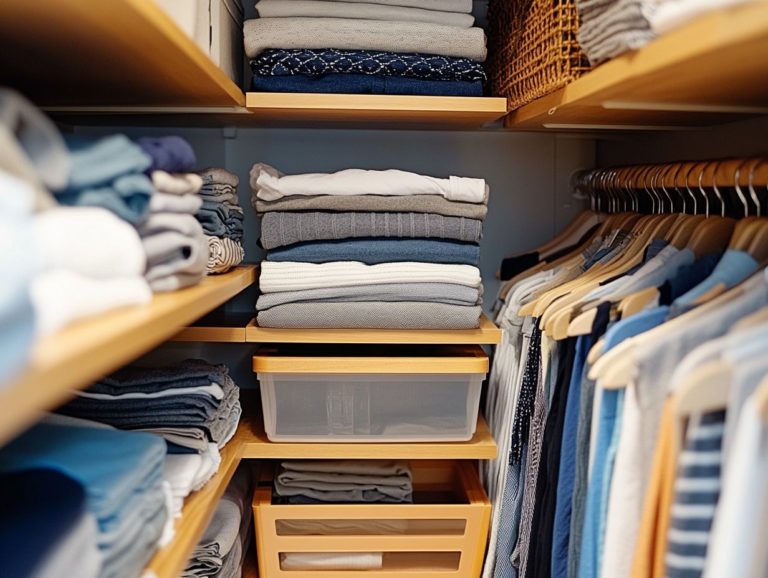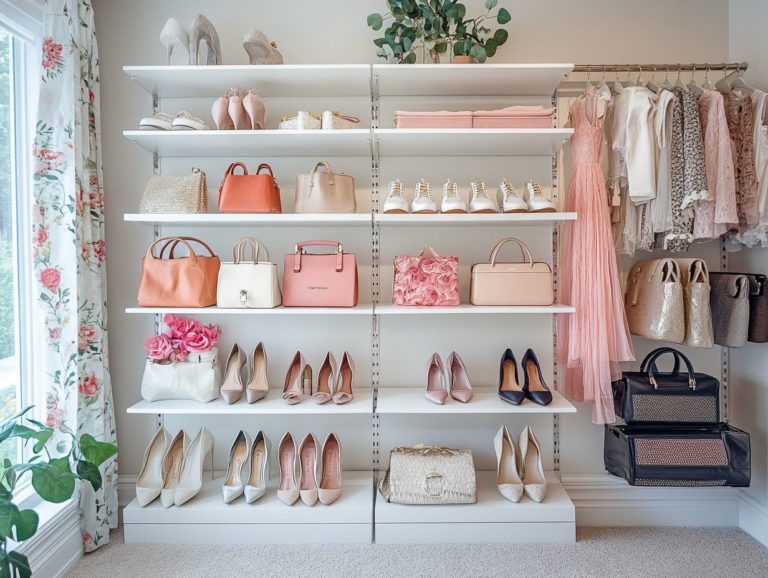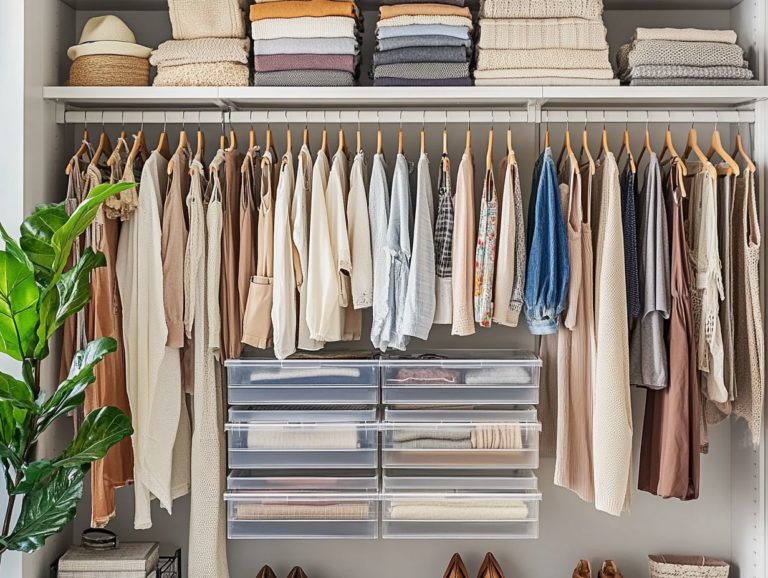7 Strategies for Decluttering Kids’ Closets
Decluttering your kids’ closets and managing their clothing preferences may seem like a big job, but it doesn’t have to be overwhelming.
With the right strategies in hand, you can turn this often chaotic space into a beautifully organized haven. Discover seven effective organizing tips to engage your children in the decluttering process, regularly sort through their kids’ clothes, and maintain a tidy closet.
You will also discover many benefits of decluttering for the entire family, ensuring that everyone enjoys a more organized home and a stress-free environment. Prepare to create a clutter-free space that your kids will truly appreciate!
Contents
- Key Takeaways:
- 1. Involve Your Kids in the Process
- 2. Sort Through Clothes Regularly
- 3. Keep Seasonal Items Separate
- 4. Use Storage Solutions
- 5. Donate or Sell Unwanted Clothes
- 6. Create a System for Organizing Clothes
- 7. Encourage Kids to Keep Their Closets Tidy
- How Can Decluttering Kids Closets Benefit the Whole Family?
- What Are the Benefits of Involving Kids in the Decluttering Process?
- What Are Some Tips for Sorting Through Clothes Regularly?
- How Can Seasonal Items Be Stored Effectively?
- What Are Some Recommended Storage Solutions for Kids Closets?
- How Can Parents Help Kids Decide What Clothes to Donate or Sell?
- What Are Some Creative Ways to Organize Kids Clothes?
- How Can Parents Teach Kids to Maintain a Tidy Closet?
- Frequently Asked Questions
- What are the 7 strategies for decluttering kids closets?
- Why is it important to involve my child in the decluttering process?
- How can I effectively sort and categorize items in my child s closet?
- What should I do with items that my child has outgrown or no longer uses?
- What are some storage solutions for a child s closet?
- How can I maintain organization in my child s closet on a regular basis?
Key Takeaways:
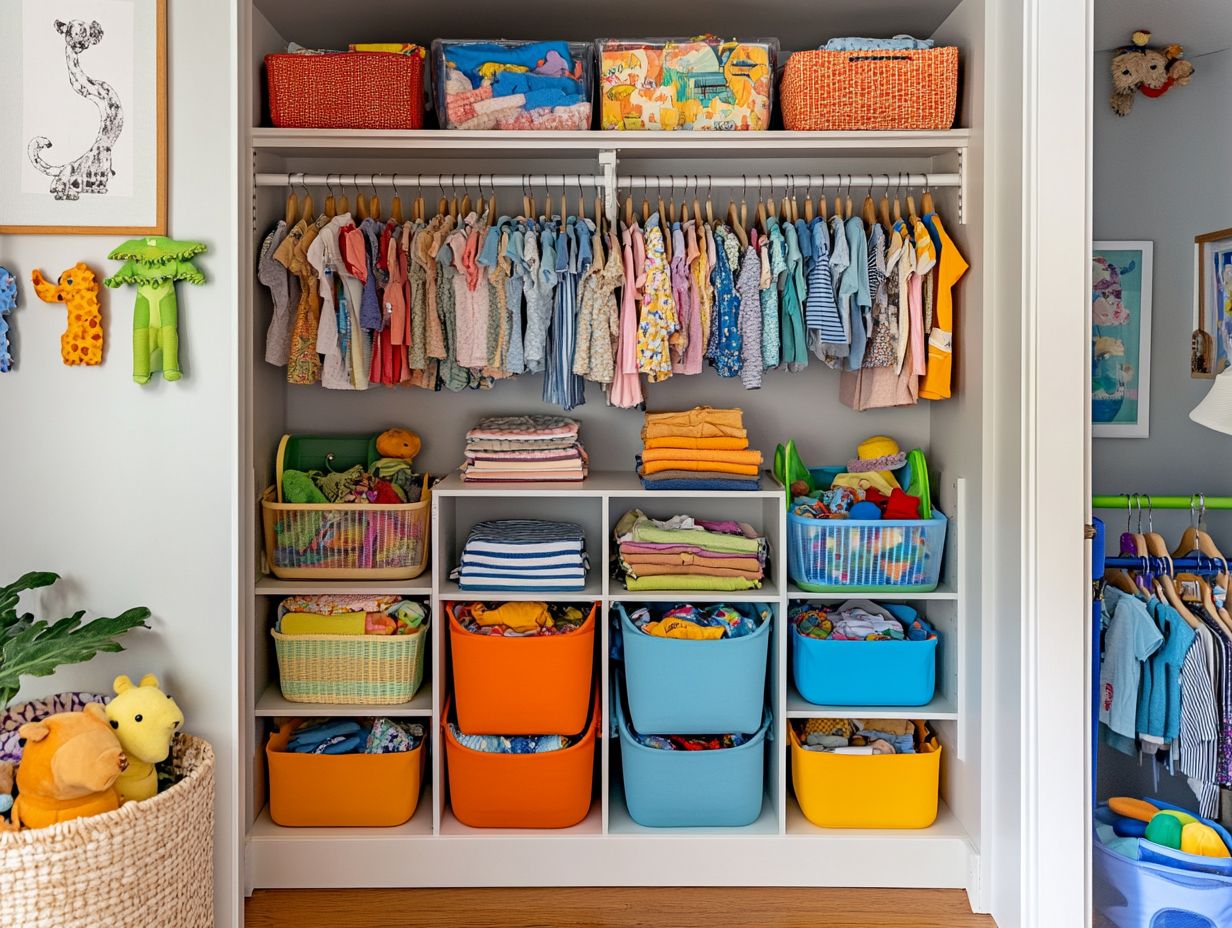
- Involve your kids in decluttering to teach them responsibility and decision-making skills.
- Sort through clothes regularly to keep closets organized and make space for new items.
- Store seasonal items separately to save space and make them easily accessible when needed.
1. Involve Your Kids in the Process
Involving your kids in the decluttering process is crucial for instilling the significance of a clean bedroom and developing healthy clothing habits. This not only ensures that their wardrobe reflects their personal style, but also transforms the task into a more enjoyable and manageable experience.
This collaborative effort fosters a sense of responsibility, giving your children the power to make thoughtful choices about their clothes. Ultimately, this helps create a more organized home environment.
To elevate the experience, consider turning decluttering into a fun summer project filled with music and snacks. Incorporating games like sorting clothes into categories or racing to see who can fill a donation bag the fastest can inject excitement into the process.
It’s important for your kids to understand what clothes they really need! Engage them in conversations about what they actually wear versus what merely occupies space. By sharing the responsibility of maintaining an organized wardrobe, they not only learn valuable life skills but also come to understand that keeping their space tidy is an important part of their role within the family. This, in turn, contributes to overall clutter reduction.
2. Sort Through Clothes Regularly
Regularly sorting through your kids’ clothes is essential for maintaining an organized wardrobe and enhancing their clothes donation efforts. It helps prevent clutter from piling up and leads to less laundry and a more efficient system for managing their clothes.
Checking what clothes they have at the beginning of each season allows you to assess what s truly necessary and what can be set aside or donated. This process refreshes the wardrobe and helps you understand the needs for the upcoming months, ensuring that only fitting and functional pieces remain.
To make sorting more manageable, categorize items based on their usage daily wear, special occasions, or seasonal gear. Evaluating the size and condition of each piece makes it easier to decide what to keep, repair, or let go ensuring that items are either stored correctly or prepared for donation.
This streamlines the decluttering process and creates a more organized, functional space for your child s wardrobe.
3. Keep Seasonal Items Separate
Keeping seasonal items separate and utilizing storage bins is essential for simplifying your wardrobe. This approach allows for better organization and easier access to clothes that are relevant to the current season while optimizing storage solutions in your kids’ closets.
Utilizing sturdy storage bins helps achieve this goal while also contributing to a clutter-free environment. They not only protect items from dust and damage but also make it easy to identify contents at a glance. Labeling each bin with clear, descriptive tags enhances accessibility, allowing you to quickly retrieve and return seasonal clothes as needed.
By adopting these strategies, you can enjoy a clutter-free environment that enhances your time management during wardrobe transitions and prepares your kids for school. An organized system streamlines your daily routines, and it also helps preserve the longevity of seasonal wear, ensuring that each piece maintains its quality for years to come.
Start the decluttering process today for a happier, organized home!
4. Use Storage Solutions
Using effective storage solutions is essential for organizing your kids’ clothes and managing their clothing habits. It transforms chaotic spaces into sleek, organized interiors, making it effortless to find and manage clothing.
You have various options think sturdy storage bins, adjustable shelves, and customized closet organizers. These elements enhance the functionality of your child’s wardrobe. They not only create specific spots for everything but also encourage your kids to take responsibility for tidying up.
For example, use bins for seasonal clothing or toys. Shelves are perfect for neatly folded garments and accessories, supporting wardrobe simplification. By maximizing vertical space, you can effectively prevent overflow and ensure that every piece of clothing has its dedicated spot.
Incorporating labels can streamline the identification process, making daily dressing both efficient and enjoyable for everyone.
5. Donate or Sell Unwanted Clothes
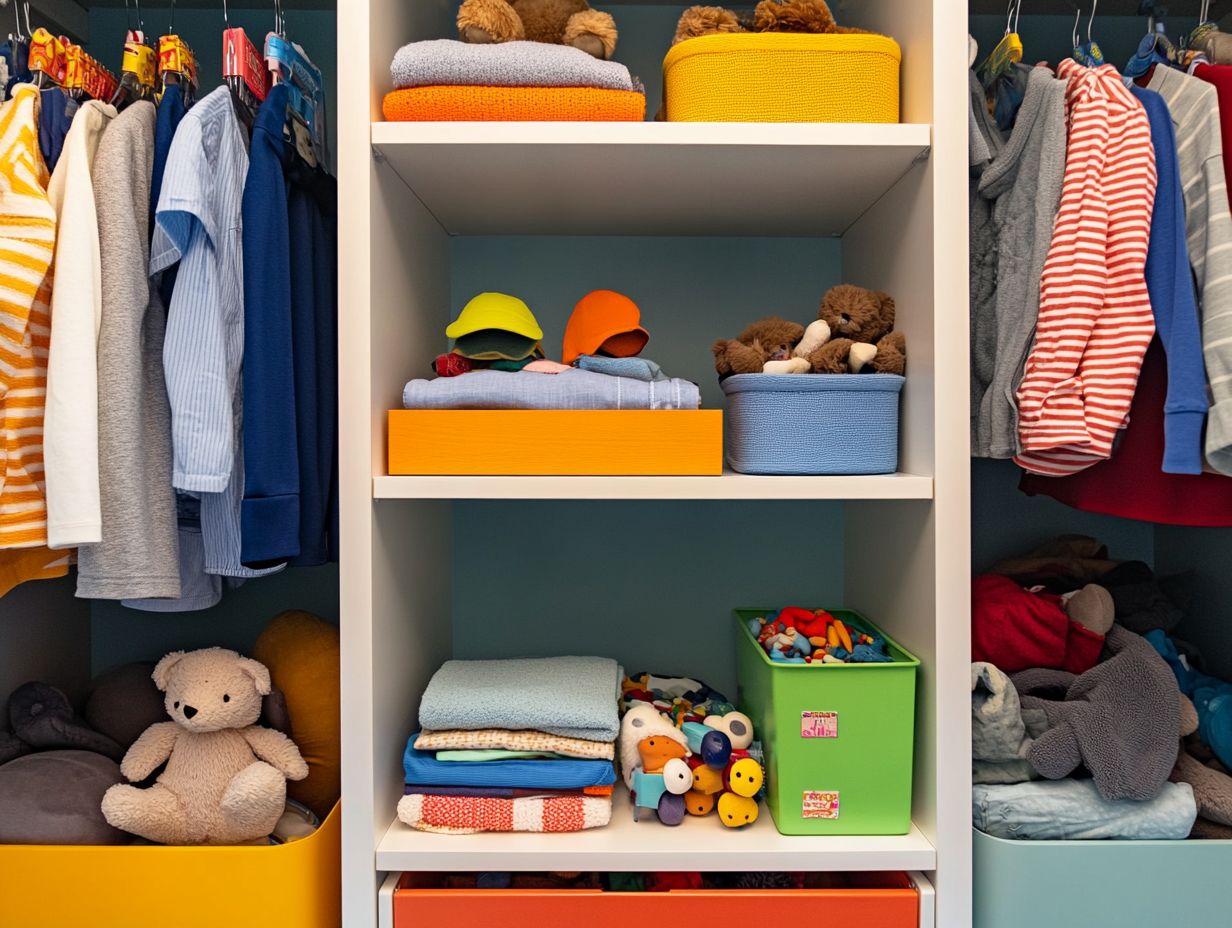
Donating or selling unwanted clothes does more than clear out your closet. It instills values of generosity and sustainability in your children, creating a rewarding experience that resonates with their clothing needs and preferences.
Start by sorting through your wardrobe and identifying gently used items that are still stylish and suitable for others. This ensures a good clothes donation.
Lightly worn shoes, jackets, and seasonal clothing are prime candidates for donation or resale.
Platforms like ThredUp provide convenient avenues for selling pre-loved garments. Local charities such as Goodwill eagerly accept donations that benefit your community.
By engaging in this process, your family declutters your living space and contributes to a positive cycle of giving. This reinforces the importance of caring for others and understanding their clothing needs.
6. Create a System for Organizing Clothes
Establish a systematic approach to organizing your kids’ clothes. This includes setting a clothes limit, making it easier for them to select outfits each day and nurturing a sense of responsibility over their wardrobe.
Embrace the concept of a capsule wardrobe, which is a small collection of essential clothing items that can be mixed and matched. This minimalist approach simplifies daily decisions and fosters an appreciation for quality over quantity.
To maximize efficiency, categorize these essentials by type or color. This creates a visually appealing and functional space. Involving your kids in the organization allows them to express their personal style while developing essential decision-making skills.
7. Encourage Kids to Keep Their Closets Tidy
Get your kids excited about keeping their closets tidy! This is crucial for cultivating an organized environment and nurturing lifelong cleaning habits.
Set a clothes limit to teach children about balance and simplify managing their wardrobes. Establish a routine for closet upkeep, like a weekly organizing session, to foster a sense of responsibility.
Introduce fun rewards for keeping their spaces clean like extra screen time or a small treat. This strategy can spark motivation, enabling kids to take pride in their organizational efforts.
Transform cleanup chores into enjoyable activities they genuinely look forward to while learning valuable management tips. Start today to create a clutter-free space that your family will love!
How Can Decluttering Kids Closets Benefit the Whole Family?
Decluttering your kids closets and donating clothes brings a host of benefits to the entire family. It turns chaotic spaces into organized sanctuaries that promote cleanliness and create a harmonious environment where everyone can thrive.
When families take the initiative to tidy up shared spaces, they often find a remarkable reduction in stress and anxiety. An organized closet helps your children locate and store their belongings with ease. This nurtures their independence and sense of responsibility, allowing them to manage less laundry.
Picture this excitement: when everyone knows exactly where things belong, including the donation pile, the morning routine transforms into a smooth operation. You can enjoy leisurely breakfasts instead of scrambling around in a frenzy. A decluttered home encourages collaboration; family members can come together to maintain the neatness, strengthening those bonds through shared tasks of managing their wardrobe.
This collective effort enhances overall well-being. A tidy space fosters heightened focus and increased productivity, allowing everyone to engage more fully in their daily activities and embrace their role in the family.
What Are the Benefits of Involving Kids in the Decluttering Process?
Involving kids in the decluttering process equips them with invaluable life skills. It emphasizes the significance of responsible clothing habits and cleanliness while transforming the experience into something interactive and enjoyable, reinforcing their clothing needs.
By actively engaging them in sorting through their clothes, they learn to make decisions based on their own preferences and needs, enhancing their decision-making skills. As they evaluate what to keep or donate, they cultivate a deeper understanding of their clothing requirements, fostering a sense of ownership over their belongings.
This hands-on approach promotes a sense of responsibility. Children begin to recognize how their choices impact their space. When they participate in these activities, they are more likely to develop positive attitudes toward cleaning and organization, seeing it as a rewarding aspect of life rather than just another chore.
What Are Some Tips for Sorting Through Clothes Regularly?
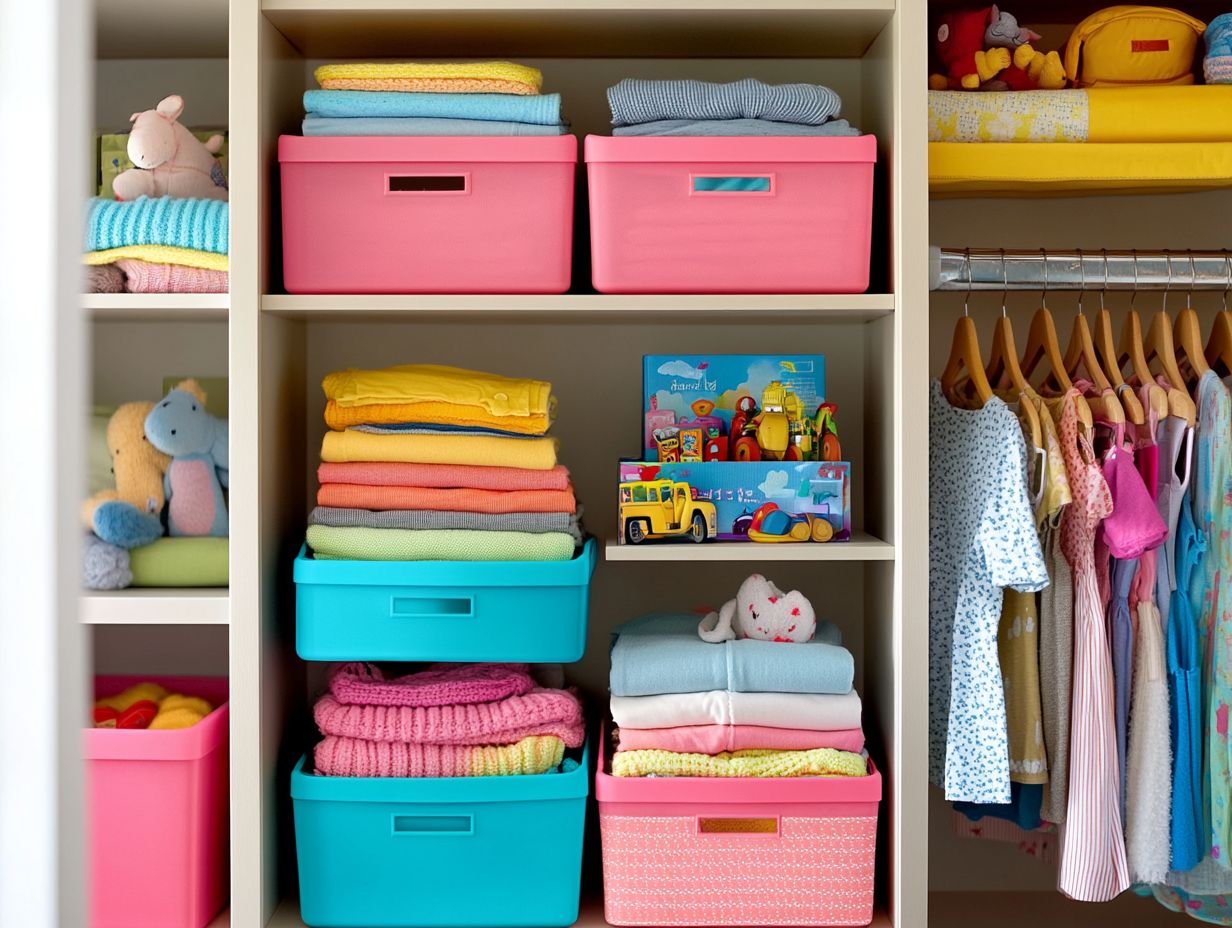
Regularly sorting through your clothes is essential for maintaining a well-organized wardrobe. Utilizing effective management tips can transform this task into a more efficient and manageable endeavor.
To kick things off, establishing a seasonal schedule can help you maintain a consistent routine, ensuring that nothing slips through the cracks. Involving your children in the process imparts valuable organizational skills and nurtures a sense of responsibility for their belongings.
Conducting a clothing audit is a perfect opportunity to evaluate what truly deserves a spot in your wardrobe. Ask yourself questions like, “Have I worn this in the past year?” or “Does this still align with my current style?” The answers will guide your decisions about which items to keep, donate, or discard, ultimately leading to a more streamlined collection that you can truly appreciate.
How Can Seasonal Items Be Stored Effectively?
Effective storage of seasonal items is essential for keeping your interior organized. This allows you to easily access weather-appropriate clothing while minimizing clutter in your kids’ closets.
To achieve this, consider implementing practical strategies such as using labeled storage bins that categorize items by season or type. Vacuum-sealed bags, which remove air to save space, can help store clothes neatly.
Creating designated areas in your closets for different seasonal wardrobes ensures everything is in its rightful place, making transitions between seasons a breeze. It s wise to rotate these items every six months to maintain an efficient organization system, ensuring your clothing reflects current weather needs without overwhelming your available space.
What Are Some Recommended Storage Solutions for Kids Closets?
Finding the right storage solutions for your kids closets can turn chaotic spaces into beautifully organized interiors. This makes it much easier for your children to locate and manage their clothes.
By incorporating various storage options, such as shelves that go up high, bins, and hanging organizers, you can create functional yet visually appealing spaces. When selecting the best solutions, consider the size and layout of the closet. For example, shelves that go up high maximize height in smaller rooms, while wider bins are perfect for bulkier items.
Using hanging organizers can free up valuable floor space and grant easy access to frequently used garments. For inspiration, explore customizable shelving or themed bins that make cleanup a fun activity for your children, fostering responsibility and independence along the way!
How Can Parents Help Kids Decide What Clothes to Donate or Sell?
Parents play a pivotal role in guiding children as they learn to decide which clothes to donate or sell. This nurtures their understanding of clothing needs and the importance of giving back to the community.
Engage your children in this meaningful decision-making journey by asking thoughtful questions about each piece of clothing. Inquire about its sentimental value and how often it gets worn. This encourages your child to reflect on their attachment to items while promoting a sense of practicality.
Create a tangible donation pile to elevate this activity into a fun and interactive experience. Involve your kids in sorting through their wardrobe and discussing the reasoning behind each choice to foster a sense of responsibility and empathy toward those in need.
What Are Some Creative Ways to Organize Kids Clothes?
Creative organization techniques can profoundly transform how kids manage their clothes. They simplify wardrobes and empower them to choose outfits independently.
Incorporate strategies like color-coding each item or using clear storage bins. You can craft an organized and visually inviting space that encourages children to engage with their belongings. These methods make it easy for kids to find their favorite shirts or pants and instill pride in keeping their area tidy. Additionally, learning how to maintain a decluttered closet can further enhance their space.
Repurposing everyday items, like using a shoe organizer for accessories or converting boxes for off-season clothing, sparks creativity and resourcefulness. These strategies streamline daily routines and encourage children to take responsibility for their belongings, fostering lifelong skills in organization and independence.
How Can Parents Teach Kids to Maintain a Tidy Closet?
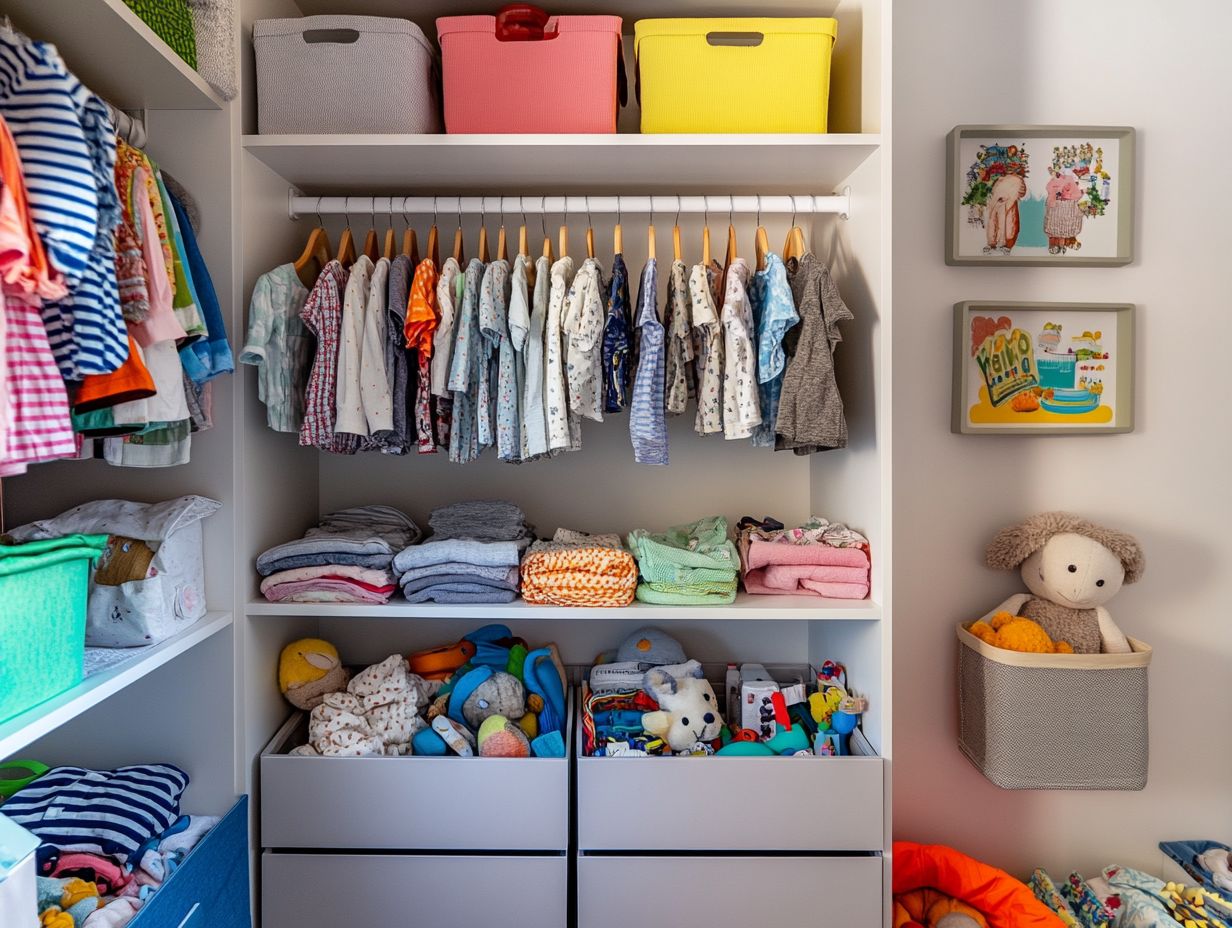
Teach your kids today how to keep their closets tidy! It s all about instilling good cleaning habits and equipping them with effective strategies to manage their belongings. This leads to a more organized and clutter-free environment that everyone will appreciate.
Establish a consistent routine; help your child carve out specific times each week to tackle organization and decluttering. Frame these moments as enjoyable family activities, reinforcing the values of teamwork and accountability.
Encourage your child to categorize their items by season, type, or frequency of use to streamline the task and make it feel less daunting.
Incorporate positive reinforcement, such as praising their efforts or offering a small reward for maintaining their tidy space. This can significantly motivate them to make these habits stick.
By approaching this task with patience and a supportive attitude, you nurture lifelong skills in your child that will serve them well beyond their closet.
Frequently Asked Questions
What are the 7 strategies for decluttering kids closets?
Wondering how to declutter your kids closets? Here are seven effective strategies:
- Set a goal
- Involve your child
- Sort and categorize
- Donate or sell unused items
- Utilize storage solutions
- Create a system for rotation
- Maintain organization regularly
Start organizing your kids closets today and share your experiences!
Why is it important to involve my child in the decluttering process?
Involving your child in decluttering helps them learn the value of organization. They also get a say in what stays in their closet, which encourages them to keep things organized later on.
How can I effectively sort and categorize items in my child s closet?
Begin by emptying the closet and sorting items into categories like tops, bottoms, and jackets. Next, go through each category and decide what to keep, give away, or sell to create a better-organized space.
What should I do with items that my child has outgrown or no longer uses?
You can give away or sell these items. Donating them helps those in need, while selling online or at consignment stores can earn you extra money.
What are some storage solutions for a child s closet?
Consider using hanging shelves, bins, baskets, over-the-door organizers (which are great for storing small items), and hooks. These solutions maximize space and make items easy for your child to access.
How can I maintain organization in my child s closet on a regular basis?
Choose a specific day each month to sort through the closet and remove unneeded items. Encourage your child to return clothes and toys to their places after use. Don’t wait too long! Regularly checking the closet keeps it clutter-free and fun for your child.


